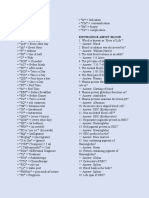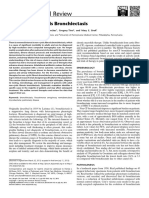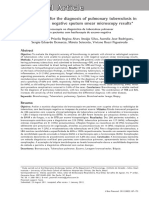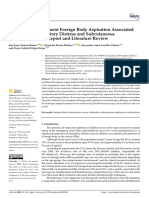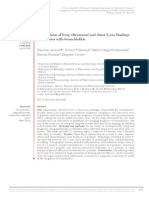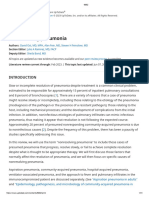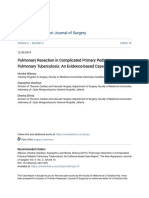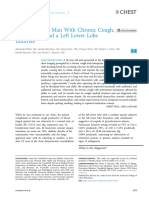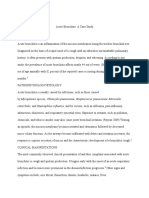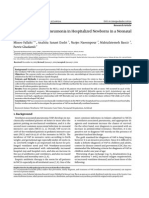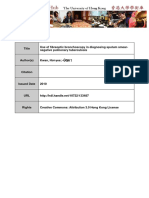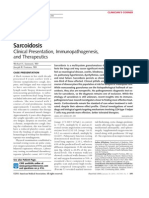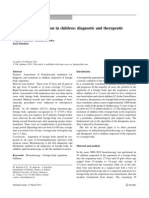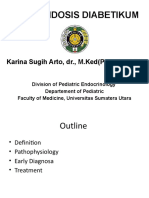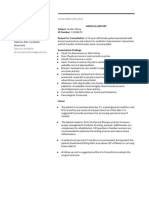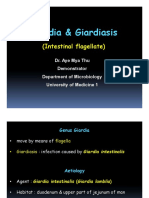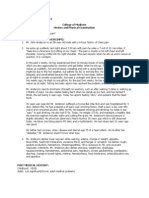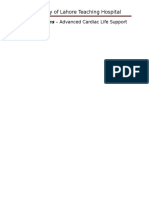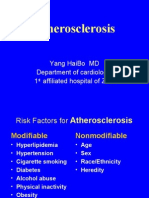Foreign Body Aspiration in Children-A Diagnostic Challenge
Foreign Body Aspiration in Children-A Diagnostic Challenge
Uploaded by
Viany RehansyahCopyright:
Available Formats
Foreign Body Aspiration in Children-A Diagnostic Challenge
Foreign Body Aspiration in Children-A Diagnostic Challenge
Uploaded by
Viany RehansyahOriginal Title
Copyright
Available Formats
Share this document
Did you find this document useful?
Is this content inappropriate?
Copyright:
Available Formats
Foreign Body Aspiration in Children-A Diagnostic Challenge
Foreign Body Aspiration in Children-A Diagnostic Challenge
Uploaded by
Viany RehansyahCopyright:
Available Formats
96 Case Report
Introduction
Foreign body aspiration (FBA) is common among children,
but sometimes there is a signicant delay until the diagnosis
is made. A delay of over three days between aspiration and
removal of the foreign body (FB) was reported in almost 30%
of children (1). The highest incidence of FBA is in children
between one to three years of age (2). A recent history of
aspiration is elicited in only 73-80% of cases, leaving up to
27% of cases unrecognized. The interval between FBA and
admission to hospital may vary between a few days to several
months, even years (3, 4). When obtained, anamnestic data
revealed symptoms such as coughing, wheezing and/or chok-
ing in 95% of cases (5, 6).
The clinical presentation of FBA can mimic other pulmo-
nary diseases, so it is obvious why a signicant number of
children are misdiagnosed (in up to 18% of cases), most often
with pneumonia, persistent fever or asthma which does not
respond to standard therapy (5, 7). The aim of this paper was
to depict the obstacles that pediatricians and radiologists
may face when dealing with a patient with unrecognized FBA.
Case Report
A previously healthy, 11-month old boy was admitted to a
local hospital with the diagnosis of acute bronchiolitis and lar-
yngitis. Except for a positive family history of asthma, all other
anamnestic data were normal. Standard therapy was initiated
and his condition gradually improved. After 4 days, he sud-
denly developed global respiratory insufciency, so he was in-
tubated and transported from the local hospital to the Pediat-
ric Intensive Care Unit (PICU) of our hospital. On admission to
PICU, he was subfebrile and dyspnoic. Auscultation revealed
symmetric low-tone wheezing and early and late inspiratory
crackles. CR was normal. Respiratory support (continuous
positive airway pressure) was initiated. The patients condi-
tion improved, so he was extubated 16 hours after admis-
sion. Two days later, he was transferred to the Pulmonology
Department. At that time, he was dyspnoic, SatO
2
was 95%
with supplemental oxygen through nasal cannulas. He had a
laryngeal cough and weakened breathing with inspiratory-ex-
piratory stridor. CR showed paracardial and consolidation of
basal parts of left lung (Figure 1A). Bronchodilatators and an-
tibiotics were continued until serological and microbiological
tests, along with negative indicators of acute inammation,
ruled out bacterial and viral etiology. Auscultatory ndings
improved, but mild wheezing persisted. Five days after cessa-
tion of antibiotics he was febrile again, reaching 40C. The CR
nding stimulated (Figure 1B) raised suspicions of bacterial
infection of the lower airways. Antibiotics were included in
the therapy and after 24 hours he became afebrile.
Despite the continuous use of bronchodilatators, signs of
bronchoobstruction persisted. He had a positive family his-
tory for asthma, so inhaled corticosteroids were added to the
therapy but had no signicant effect. Additional examinations
(cardiologist, gastroenterologist, uoroscopy of upper gas-
trointestinal tract, sweat chlorine, allergological tests as well
as mycobacterium tuberculosis tests) ruled out other possible
causes of symptoms. Poor clinical response and unclear clini-
cal condition were indications for bronchoscopy, which was
performed on the 45
th
day of hospitalization (This option was
considered earlier, but when it was suggested, the mother
Address for Correspondence: Dr. Slobodanka Petrovic, Institute for Child and Youth Health Care of Vojvodina, Novi Sad, Serbia
Phone: + 381 64 2115233 E-posta: bakiboy@sezampro.rs
Balkan Med J 2012; 29: 96-8 DOI: 10.5174/tutfd.2010.04545.1
Trakya University Faculty of Medicine
Foreign Body Aspiration in Children-a Diagnostic Challenge
1
Institute for Child and Youth Health Care of Vojvodina, Novi Sad, Serbia
2
Clinical Center of Vojvodina, Institute for Radiology, Novi Sad, Serbia
Slobodanka Petrovic
1
, Svetlana Cegar
1
, Jovan Lovrenski
1
, Nenad Barisic
1
, Viktor Till
2
ABSTRACT
The clinical presentation of foreign body aspiration in children is variable. Clinicians should maintain a high index of suspicion in order to make a prompt
and correct diagnosis. In this paper,we present a case of foreign body aspiration that had gone unrecognized for 54 days. Foreign body aspiration
should be considered whenever a previously healthy child suddenly exhibits unexplained symptoms usually consistent with airway obstruction which is
refractory to medical treatment.
Key Words: Bronchoscopy, children, foreign body aspiration, prolonged diagnosis
Received: 02.09.2010 Accepted: 25.10.2010
had refused to give consent for the procedure). Bronchoscopy
revealed complete obstruction of the left main bronchus with
a soft tissue mass. After partial extraction of the mass, inam-
mation and granulomatous changes of mucosa were observed
at the posterior wall of the proximal part of the bronchus. The
procedure was ended because of the hemorrhage and pos-
sibility of complications. Two days later, contrast enhanced
computed tomography (CECT) was performed using 2.5 mm
section thickness and 0.6 mm reconstruction interval for mul-
tiplanar reformatted (MPR) imaging (Figure 2).
After 7 days of intravenous corticosteroid therapy, bron-
choscopy ndings were improved. A mucus plug with detritus
was extracted at 5 mm distance below the bifurcation. FB was
visualized and removed. It was a semioval shaped piece of
plastic, 10x3 mm in size, with partially sharp edges on the 54
th
day of hospitalization. Complete regression of all respiratory
symptoms followed.
Discussion
The most important criteria to raise a suspicion to FBA are
anamnestic data. They are elicited in 70-80 % of cases, mean-
ing that such data are absent in up to 27% of patients (3, 4,
6, 8). In such cases, the interval between inhalation and ad-
mission to the hospital may vary between few days to several
months or years (4). Delays attributable to patients behavior
or circumstances are most common in young children when
the FBA event was unwitnessed (3). In our case, there was
no anamnestic data pointing to FBA. The symptoms that ap-
peared rst-laryngeal cough, hoarseness and dyspnea, were
indicative of upper airway infection. Acute respiratory fail-
ure and global respiratory insufciency probably developed
due to positioning of the foreign body in the laryngeal re-
gion. During emergency intubation, FB was pushed further
into the distal parts of the airways, which was the cause of
inspiratory-expiratory and, later on, constant wheezing. Fur-
thermore, misleading information such are the atopic status
of the patient and poor social background, raised suspicions
of diseases with similar presentation.
When FBA is suspected, CR is requested. Normal CR does
not rule out FB aspiration. In children younger than 3 years
of age, in 80% of cases FBs are not visible on CR (8).
Findings
on CR can reveal secondary changes in the associated lung or
pulmonary lobe as obstructive emphysema or overination of
the lung or lobe distal to the airway obstruction. In our case,
CR was not very helpful. CT can be used in all doubtful cases
to determine bronchiectasis or other conditions, and is proved
to be better than CR in depicting radiolucent FBs which far
outnumber radiopaque ones (9, 10). Following the contem-
porary approach to pediatric radiology, based on the ionizing
radiation reduction because of its harmful effects, we used CT
as the last diagnostic choice (11-15). Although some studies
demonstrated the efciency of virtual bronchoscopy (16), it is
a time consuming procedure which, in our experience, does
not provide additional information to MPR imaging. A similar
opinion was stated in the study of Kocaoglu et al. (17)
but,
even a CT examination did not allow the nal diagnosis to be
made. The most striking feature was the complete discrep-
ancy between CR and CT ndings after the rst bronchoscopy,
which occurred within only two days. Although, in those two
days, left bronchus occlusion probably prograded, the most
probable reason for such discrepancy was the retrocardial po-
sition of lung consolidation, so it was superimposed on the
cardiac silhouette on CR.
Radiological ndings should not inuence the decision
about treatment and should not delay bronchoscopy in chil-
dren with a suspicion of aspiration (3, 18). Because compli-
cations such as pneumonia, granulation tissue formation, and
bronchiectasis increase if the diagnosis is delayed, early bron-
choscopy is preferred. Unfortunately, in our case, bronchos-
copy was delayed due to administrative reasons (initially the
mother refused to give consent for the procedure). Further,
when bronchoscopy was performed for the rst time, com-
plete occlusion of the left bronchus, hemorrhage and high risk
of serious complications (e.g. perforation) prevented a nal
diagnosis. During that time, the left bronchus was occluded
by granulation tissue, but the nature of the foreign body (plas-
tic) did not allow xation of FB to the wall of bronchus. Finally,
that enabled the bronchoscopic approach to the FB and ex-
traction after a course of corticosteroid therapy.
Prompt and accurate diagnosis of FBA can be achieved
with early bronchoscopy, which is essential for reducing as-
sociated morbidity and mortality.
Figure 1. A) Paracardial and basal opacities of the left lung.
B) Asymmetric lung volumes with hyperinflated and hyper-
lucent right lung
A B
Figure 2. A) Axial CECT images show lung consolidation on
the left with visible bronchogram, along with loss of volume
on the same side, combined with segmental hyperinflation.
B) Coronal MPR show 23mm long hypodense content wit-
hin the left main bronchus, starting 5mm below bifurcation,
and entering the proximal part of the lobar bronchus. It had
an appearance of a mucus plug
A B
97
Balkan Med J
2012; 29: 96-8
Petrovic et al.
FBA in Children
Conict of Interest
No conict of interest was declared by the authors.
References
1. Tan H.K.K, Brown K, McGill T, Kenna M.A, Lund D.P, Healy G.B.
Airway foreign bodies (FB): a 10 year review. Int J Pediatr Otorhi-
nolaryngol 2000;56:91-9. [CrossRef]
2. Gandhi R, Jain A, Agarwal R, Vajifdar H. Tracheobronchial For-
eign Bodies- A seven years review. J Anesth Clin Pharmacology
2007;23:69-74.
3. Silva A.B, Muntz H.R, Clary R. Utility of conventional radiogra-
phy in the diagnosis and management of pediatric airway foreign
bodies. Ann Otol Rhinol Laryngol 1998;107:834-8.
4. Mul C, Sun DO, He P. Radiological diagnosis of aspirated for-
eign bodies in children: review of 343 cases. J Laryngol Otol
1990;104:778-82.
5. Reilly J, Thompson J, MacArthur C, Pransky S, Beste D, Smith
M, et al. Pediatric aerodigestive foreign body injuries are com-
plications related to timeliness of diagnosis. Laryngoscope
1997;107:17-20. [CrossRef]
6. Darrow DH, Holinger LD. Aerodigestive tract foreign bodies in
the older child and adolescent. Ann Otol Rhinol Laryngol 1996;
105:267-71.
7. Daines CL, Wood RE, Boesch RP. Foreign body aspiration: An
important etiology of respiratory symptoms in children. J Allergy
Clin Immunol 2008;121:1297-8. [CrossRef]
8. Deskin R, Young G, Hoffman R. Managementof pediatric airway
foreign bodies. Laryngoscope 1997;107:540-3. [CrossRef]
9. Franquet T, Gimenez A, Ronson N, Torrubia S, Sabate IM, Perez
C. Aspiration disease: nding, pitfalls, and differential diagnosis.
RadioGraphic 2000;20:673-85.
10. Donnellyl F, Frush DP, Risset GS 3rd. The multiple presentations of
foreign bodies in children. AJR Am Roentgenol 1998;170:471-7.
11. Brenner DJ, Elliston CD, Hall EJ, Berdon WE. Estimated risks of
radiation-induced fatal cancer from pediatric CT. Am J Roent-
genol 2001;176:289-96.
12. Shu XO, Potter JD, Linet MS, Severson RK, Han D, Kersey JH, et
al. Diagnostic x-rays and ultrasound exposure and risk of child-
hood acute lymphoblastic leukemia by immunophenotype. Can-
cer Epidemiol Biomarkers Prev 2002;11:177-85.
13. Infante-Rivard C, Mathonnet G, Sinnett D. Risk of childhood leu-
kemia associated with diagnostic irradiation and polymorphisms
in DNA repair genes. Environ Health Perspect 2000;108:495-8.
[CrossRef]
14. Mazrani W, McHugh K, Marsden PJ. The radiation burden of
radiological investigations. Arch Dis Child 2007;92:1127-31.
[CrossRef]
15. Hall E.J. Lessons we have learned from our children: cancer
risks from diagnostic radiology. Pediatr Radiol 2002;32:700-6.
[CrossRef]
16. Cevizci N, Dokucu AI, Baskin D, Karada CA, Sever N, Yalin M,
et al. Virtual bronchoscopy as a dynamic modality in the diag-
nosis and treatment of suspected foreign body aspiration. Eur J
Pediatr Surg 2008;18:398-401. [CrossRef]
17. Kocaoglu M, Bulakbasi N, Soylu K, Demirbag S, Tayfun C, So-
muncu I. Thin-section axial multidetector computed tomography
and multiplanar reformatted imaging of children with suspected
foreign-body aspiration: Is virtual bronchoscopy overempha-
sized? Acta Radiol 2006;47:746-51. [CrossRef]
18. Esclamado RM, Richardson MA. Laryngotracheal foreign bodies
in children. A comparison with bronchial foreign bodies. Am J Dis
Child 1987;141:259-62.
98
Balkan Med J
2012; 29: 96-8
Petrovic et al.
FBA in Children
You might also like
- Atlas of Full Breast Ultrasonography - 1st PDFDocument392 pagesAtlas of Full Breast Ultrasonography - 1st PDFIosub Lica-Claudiu100% (3)
- Páginas Desdepharmacotherapy Casebook 10th Ed.Document61 pagesPáginas Desdepharmacotherapy Casebook 10th Ed.Glo VsNo ratings yet
- Common Medical AbbreviationsDocument4 pagesCommon Medical AbbreviationsApril Joy de LimaNo ratings yet
- Retracted Article2Document6 pagesRetracted Article2AyuAnatrieraNo ratings yet
- Case 1: Recurrent Pneumonia in A 15-Year-Old Girl: Article Figures & Data Info & Metrics CommentsDocument7 pagesCase 1: Recurrent Pneumonia in A 15-Year-Old Girl: Article Figures & Data Info & Metrics CommentsJoshua MendozaNo ratings yet
- Large Pulmonary Solitary Mass Caused by Mycobacterium Tuberculosis Mimicking A Malignant Tumor in A ChildDocument4 pagesLarge Pulmonary Solitary Mass Caused by Mycobacterium Tuberculosis Mimicking A Malignant Tumor in A Childadipspain981No ratings yet
- Emergencias Respiratorias Pediatricas PDFDocument20 pagesEmergencias Respiratorias Pediatricas PDFMarco Antonio Mendoza OjedaNo ratings yet
- Neu Motor AxDocument6 pagesNeu Motor AxZay SiagNo ratings yet
- Review Article: Challenges in Endobronchial Tuberculosis: From Diagnosis To ManagementDocument9 pagesReview Article: Challenges in Endobronchial Tuberculosis: From Diagnosis To ManagementInsinyur_077No ratings yet
- Case Report Displasia BronkopulmonerDocument5 pagesCase Report Displasia BronkopulmonerVivi DeviyanaNo ratings yet
- Radiological Findings of Pulmonary Tuberculosis in Infants and Young ChildrenDocument4 pagesRadiological Findings of Pulmonary Tuberculosis in Infants and Young ChildrenEva ZheichuaNo ratings yet
- 3124 23811 1 PBDocument8 pages3124 23811 1 PBlinamaria.pedNo ratings yet
- Fischer2010 - Cretiria - Post Infectious Bronchiolitis Obliterans in ChildrenDocument7 pagesFischer2010 - Cretiria - Post Infectious Bronchiolitis Obliterans in ChildrenvuongNo ratings yet
- Tuberculosis Masquerading As Recurrent Metastatic Carcinoma of The CervixDocument2 pagesTuberculosis Masquerading As Recurrent Metastatic Carcinoma of The Cervixpaijosuseno2242No ratings yet
- Management of Pneumonia Syndromes in The HospitalDocument13 pagesManagement of Pneumonia Syndromes in The HospitalKelly Enedina NunesNo ratings yet
- Tuberculosis - Are We Missing The Diagnosis?: Y IsmailDocument5 pagesTuberculosis - Are We Missing The Diagnosis?: Y IsmailJim KokNo ratings yet
- Concise Clinical Review: Non-Cystic Fibrosis BronchiectasisDocument11 pagesConcise Clinical Review: Non-Cystic Fibrosis BronchiectasisJuwitaNo ratings yet
- En V38n2a04Document7 pagesEn V38n2a04Ana MercadoNo ratings yet
- Hermansky-Pudlak Syndrome: Case ReportDocument3 pagesHermansky-Pudlak Syndrome: Case ReportAjanapakhi SahaNo ratings yet
- Management of Primary Spontaneous Pneumothorax in Chinese ChildrenDocument7 pagesManagement of Primary Spontaneous Pneumothorax in Chinese ChildrenArsy Mira PertiwiNo ratings yet
- Seear 2017Document8 pagesSeear 2017Lucia NiculaeNo ratings yet
- MedicinaDocument8 pagesMedicinaJose Juan Gómez RamosNo ratings yet
- Jurnal RespiDocument5 pagesJurnal RespiReza MaulanaNo ratings yet
- Imaging Cystic Fibrosis: A Case StudyDocument20 pagesImaging Cystic Fibrosis: A Case StudyqalbiNo ratings yet
- (UpToDate) Nonresolving PneumoniaDocument31 pages(UpToDate) Nonresolving Pneumonia11CT2-24- Nguyễn Ngọc Minh KhôiNo ratings yet
- Diagnostic Delay MoroccoDocument5 pagesDiagnostic Delay MoroccoOmaima ElyounsiNo ratings yet
- Fluminant Pertussis PDFDocument11 pagesFluminant Pertussis PDFDooriitha Pérez Peralta100% (1)
- Enf. Intersticial2015 PDFDocument8 pagesEnf. Intersticial2015 PDFmedicomauroNo ratings yet
- Thesis TB and ChestDocument5 pagesThesis TB and Chestirugqgajd100% (1)
- FPI Progn TratDocument13 pagesFPI Progn TratTurcu AndreeaNo ratings yet
- Aspiration Pneumonia in Children With Neurological Disorders A New Indication For Lung Ultrasound A Case SeriesDocument7 pagesAspiration Pneumonia in Children With Neurological Disorders A New Indication For Lung Ultrasound A Case SeriesMuhammad Iqwan MHNo ratings yet
- Pulmonary Resection in Complicated Primary Pediatric Pulmonary Tuberculosis - An Evidence-Based Case ReportDocument5 pagesPulmonary Resection in Complicated Primary Pediatric Pulmonary Tuberculosis - An Evidence-Based Case ReportZahira AmaaliaNo ratings yet
- A 56 Year Old Man With Chronic Cough, HemoptysisDocument4 pagesA 56 Year Old Man With Chronic Cough, HemoptysisagamerocallejasNo ratings yet
- N N N N: Outcomes in Children Treated For Persistent Bacterial BronchitisDocument3 pagesN N N N: Outcomes in Children Treated For Persistent Bacterial BronchitisJohalyn Esther AlvarezNo ratings yet
- Klebsiella Pneumoniae Communiy-Acquired Pneumonia in A Trisomic at Omar Bongo Ondimba's Army Instruction Hospital (HIA OBO)Document2 pagesKlebsiella Pneumoniae Communiy-Acquired Pneumonia in A Trisomic at Omar Bongo Ondimba's Army Instruction Hospital (HIA OBO)Peertechz Publications Inc.No ratings yet
- Post-Infectious Bronchiolitis Obliterans in Children: A Review of 42 CasesDocument6 pagesPost-Infectious Bronchiolitis Obliterans in Children: A Review of 42 CasesSoniJfreeNo ratings yet
- The Accuracy of Ultrasound-Guided Lung Biopsy Pathology andDocument8 pagesThe Accuracy of Ultrasound-Guided Lung Biopsy Pathology andHeru SigitNo ratings yet
- Acute Bronchitis Case StudyDocument6 pagesAcute Bronchitis Case Studyulka0750% (2)
- Klebsiella PDFDocument4 pagesKlebsiella PDFOscarEduardoNo ratings yet
- Title Use of Fibreoptic Bronchoscopy in Diagnosing Sputum Smear-Negative Pulmonary TuberculosisDocument46 pagesTitle Use of Fibreoptic Bronchoscopy in Diagnosing Sputum Smear-Negative Pulmonary TuberculosisHam FGNo ratings yet
- Case Report: Hydropneumothorax in Children: A Rare Complication of A Bacterial PneumoniaDocument5 pagesCase Report: Hydropneumothorax in Children: A Rare Complication of A Bacterial PneumoniaNadya NovianiNo ratings yet
- Barratt 2018Document21 pagesBarratt 2018Examenes LaboratorioNo ratings yet
- III. The Radiology of Chronic Bronchitis: P. Lesley BidstrupDocument14 pagesIII. The Radiology of Chronic Bronchitis: P. Lesley BidstrupRifa Azizah AlamsyahNo ratings yet
- Sarcoidosis Review. JAMADocument9 pagesSarcoidosis Review. JAMARafael ReañoNo ratings yet
- Diagnostic Utility of Bronchoalveolar Lavage in Children With Complicated Intrathoracic TuberculosisDocument9 pagesDiagnostic Utility of Bronchoalveolar Lavage in Children With Complicated Intrathoracic TuberculosisFitri Amelia RizkiNo ratings yet
- Efusi Pleural in MassDocument4 pagesEfusi Pleural in MassRofi IrmanNo ratings yet
- Acute Exacerbation of Interstitial Lung Disease After Transthoracic Biopsy. Jornal Brasileiro de Pneumologia, 2024, 50Document3 pagesAcute Exacerbation of Interstitial Lung Disease After Transthoracic Biopsy. Jornal Brasileiro de Pneumologia, 2024, 50Raman SinghNo ratings yet
- Chest: Recent Advances in Chest MedicineDocument9 pagesChest: Recent Advances in Chest MedicinesmansakobiNo ratings yet
- Organizing Pneumonia: Chest HRCT Findings : Pneumonia em Organização: Achados Da TCAR de TóraxDocument7 pagesOrganizing Pneumonia: Chest HRCT Findings : Pneumonia em Organização: Achados Da TCAR de TóraxPutra PratamaNo ratings yet
- Foreign Body Aspiration in Children: Diagnostic and Therapeutic Role of BronchosDocument5 pagesForeign Body Aspiration in Children: Diagnostic and Therapeutic Role of BronchosCindy ThungNo ratings yet
- 2014 Article 33Document5 pages2014 Article 33SusPa NarahaNo ratings yet
- Best 2Document10 pagesBest 2irenaNo ratings yet
- Interstitial Lung DiseaseDocument4 pagesInterstitial Lung DiseasedewimarisNo ratings yet
- 2211-Article Text-8778-10260-10-20230620Document8 pages2211-Article Text-8778-10260-10-20230620IdmNo ratings yet
- Chest Radiographic Findings in Primary Pulmonary Tuberculosis: Observations From High School OutbreaksDocument6 pagesChest Radiographic Findings in Primary Pulmonary Tuberculosis: Observations From High School OutbreaksDeeny PukidNo ratings yet
- Print 1Document8 pagesPrint 1Zaura Meliana MulyadiNo ratings yet
- Pulmonary Pseudotumoral Tuberculosis in An Old Man: A Rare PresentationDocument3 pagesPulmonary Pseudotumoral Tuberculosis in An Old Man: A Rare PresentationNurhasanahNo ratings yet
- Jurnal 1Document5 pagesJurnal 1Vivi BinaloleNo ratings yet
- Chest Imaging Classification in Mycoplasma PneumonDocument9 pagesChest Imaging Classification in Mycoplasma PneumonAlfredo Herrera PacasiNo ratings yet
- Makalah Radiologi TB BE v0.1Document15 pagesMakalah Radiologi TB BE v0.1giovannigyoNo ratings yet
- Pulmonary Tuberculosis Literature ReviewDocument5 pagesPulmonary Tuberculosis Literature Reviewafdtvwccj100% (1)
- Delayed Diagnosis and Surgical Treatment of Bronchial Foreign BodyDocument6 pagesDelayed Diagnosis and Surgical Treatment of Bronchial Foreign BodyRizka Alifia PutriNo ratings yet
- Diagnosis and Treatment of Chronic CoughFrom EverandDiagnosis and Treatment of Chronic CoughSang Heon ChoNo ratings yet
- Kuliah S2 MGDocument35 pagesKuliah S2 MGViany RehansyahNo ratings yet
- BBC Slide Human Cytogenetics PDFDocument14 pagesBBC Slide Human Cytogenetics PDFViany RehansyahNo ratings yet
- BBC Slide EmbryogenesisDocument18 pagesBBC Slide EmbryogenesisViany RehansyahNo ratings yet
- Sr-Worksheet 2Document3 pagesSr-Worksheet 2Viany RehansyahNo ratings yet
- Ketoasidosis Diabetikum: Karina Sugih Arto, DR., M.Ked (Ped) .,Sp.A (K)Document14 pagesKetoasidosis Diabetikum: Karina Sugih Arto, DR., M.Ked (Ped) .,Sp.A (K)Viany RehansyahNo ratings yet
- USG ParuDocument28 pagesUSG ParuViany RehansyahNo ratings yet
- Kuliah S2 Dasar Air-ElekDocument38 pagesKuliah S2 Dasar Air-ElekViany RehansyahNo ratings yet
- Aa Brochure 10warnsignsDocument2 pagesAa Brochure 10warnsignsYordi AubaNo ratings yet
- Formato Informe MédicoDocument1 pageFormato Informe MédicoGustavo Adolfo GarciaNo ratings yet
- Paragua J.B Rlencm 113 Individual Output Final 1Document19 pagesParagua J.B Rlencm 113 Individual Output Final 1Jogil ParaguaNo ratings yet
- TumorDocument8 pagesTumorputyCeria86No ratings yet
- Jadual Kuliah Tahun 2 Semester 1 Sesi 2022-2023Document24 pagesJadual Kuliah Tahun 2 Semester 1 Sesi 2022-2023Yusni RahimNo ratings yet
- EM IP Interview QuestionsDocument19 pagesEM IP Interview Questionschaitanya varma100% (1)
- Approach To Floppy Infant: LT Col (DR) Bindu T Nair Professor (Pediatrics)Document56 pagesApproach To Floppy Infant: LT Col (DR) Bindu T Nair Professor (Pediatrics)Dorjee SengeNo ratings yet
- Giardia & Giardiasis: (Intestinal Flagellate)Document22 pagesGiardia & Giardiasis: (Intestinal Flagellate)Naing Lin SoeNo ratings yet
- Vasovagal SyncopeDocument13 pagesVasovagal SyncopeSaadia ShaikhNo ratings yet
- Homoeopathic Treatment of Complicated Sebaceous Cyst - A Case StudyDocument5 pagesHomoeopathic Treatment of Complicated Sebaceous Cyst - A Case StudyDr deepakNo ratings yet
- Serous Fluid Powerpoint HandoutDocument3 pagesSerous Fluid Powerpoint HandoutAnonymous ceYk4p4No ratings yet
- Altered Thought ProcessDocument17 pagesAltered Thought Processbinteazhar67% (3)
- Oral Manifestations of Asthmatic Patients: Short ReportDocument2 pagesOral Manifestations of Asthmatic Patients: Short ReportDenna Idryareza AugustyanaNo ratings yet
- Interpretation On Pulmonary Function TestDocument105 pagesInterpretation On Pulmonary Function Testsalmamaged7619No ratings yet
- Birth InjuriesDocument7 pagesBirth InjuriesWendy NyamweyaNo ratings yet
- TABLE 134 - Antipsychotic MedicationsDocument2 pagesTABLE 134 - Antipsychotic MedicationsDragutin PetrićNo ratings yet
- Hyponatremia: Presenter: DR Arun Karmakar Moderator: Prof. N. SharatkumarDocument50 pagesHyponatremia: Presenter: DR Arun Karmakar Moderator: Prof. N. SharatkumarLyra FebriandaNo ratings yet
- Autoimmune Hepatitis: Dr. Andi Nadya Febriama DR - DR Am - Lutfi Parewangi, SPPD KgehDocument25 pagesAutoimmune Hepatitis: Dr. Andi Nadya Febriama DR - DR Am - Lutfi Parewangi, SPPD KgehDeddy TrimarwantoNo ratings yet
- Patofisiologi NyeriDocument99 pagesPatofisiologi NyeriWandi WDNo ratings yet
- Top Otc DrugsDocument3 pagesTop Otc DrugsKeziah VenturaNo ratings yet
- Practice HPIDocument3 pagesPractice HPImedicalmatins100% (1)
- Goodpasture's Syndrome, Hashimoto's Thyroiditis, Graves's Disease & Type I DiabetesDocument2 pagesGoodpasture's Syndrome, Hashimoto's Thyroiditis, Graves's Disease & Type I DiabetesZara MohammedNo ratings yet
- Dengue NS1Document1 pageDengue NS1raj100% (1)
- Lingual FrenectomyDocument6 pagesLingual Frenectomysandeep lachhwaniNo ratings yet
- ICU AlgorithmsDocument45 pagesICU AlgorithmsHashimIdreesNo ratings yet
- National Vector Borne Disease ControlDocument12 pagesNational Vector Borne Disease ControlSutirtho MukherjiNo ratings yet
- Atherosclerosis: Yang Haibo MD Department of Cardiology, 1 Affiliated Hospital of ZzuDocument22 pagesAtherosclerosis: Yang Haibo MD Department of Cardiology, 1 Affiliated Hospital of Zzuapi-19916399No ratings yet


